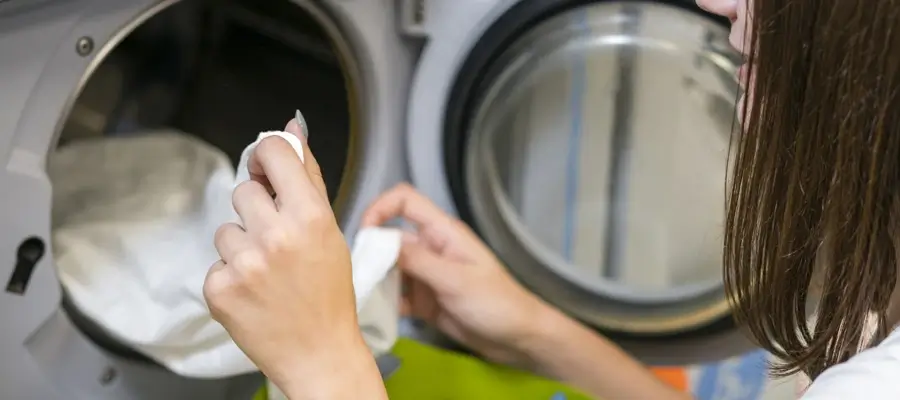6 Steps to Eliminate Front-Loading Washer Mold & Stink

Front-Loading Washers, Pros & Cons
Front-loading washing machines offer several advantages over their top-loading cousins.
- They’re gentler on clothes.
- They use less water.
- They dry clothes faster in the spin cycle.
These advantages make them a popular choice for busy households.
But front-loaders come with one significant drawback: a tendency to accumulate mold and, therefore, unpleasant smells.
They seal tightly to prevent water leakage, creating an ideal environment for mold growth. Recent redesigns have mostly eliminated this problem; still, you may encounter mold and stench, especially if you own an older front-loading model.
The good news is that you can reduce the risk of mold growth and nip it in the bud.
1. Keep the washing machine door open between loads.
Mold thrives in a moist environment. Moisture to mold is like octane for a car. Vroom vroom! Forgive the analogy if you drive a Tesla.
The key to controlling mold is preventing excess moisture. Huh? How is this supposed to happen with a washing machine, which can’t wash without water?
Well, when you empty your washer after a load and reclose the door tight, you’re sealing in moisture and creating a petri dish for mold growth.
Leave the door open at least a couple of inches to let your washer air out and dry.
Open washing machines can be tempting for toddlers and pets, so proceed with caution and close off the laundry area while you’re airing out the front loader.
2. Empty your washer promptly after the last spin cycle.
Of course, you’re going to empty the washer! Who wouldn’t?
Our point here is that a front-loading washing machine comes with a minuscule “laziness” window compared to a top-loader. You don’t have the same leeway.
When wet laundry sits in your machine for hours or even days, the odds of mold grow exponentially.
Set the washer to run at a time when you know you’ll be home, willing and able to empty it after the buzzer buzzes. Even if you can’t move your damp laundry straightaway to the dryer, or you’d rather not deal with it because you’re binging on Netflix, remove the wet clothes immediately. Place them in a basket or hamper.
3. Clean the interior of your front-loading washer periodically.
Detergent residue builds up over time, especially if you add more than the recommended amount to laundry loads. Let’s get those clothes extra clean!
The trouble is, old soap deposits don’t smell like a meadow in springtime. They smell more like effluent flow. Front-loading washing machines are especially vulnerable to detergent residue.
Some front-loading models come with a tub-washing cycle, allowing you to rinse away accumulated residue. If you’re lucky enough to have this feature on your machine, use it every month or two.
Otherwise, follow this monthly cleaning routine:
- Run your machine empty through a hot-water wash cycle.
- Pour a cup or two of white vinegar or bleach into the machine’s detergent dispenser for more cleaning power.
- If you add vinegar or bleach, run your front-loading washer through a second cycle with hot water only.
- Complete the job by drying the machine’s interior (including the detergent dispenser) with a towel.
- Afterward, leave the washer door open a few inches for drying.
4. Clean your front loader’s door gasket.
The door gasket is the rubber strip lining the opening of your front-loading washer. Without it, your machine would leak like a sieve.
Top-loading washers don’t have a door gasket for an obvious reason: gravity pulls water to the bottom of the tub. But with a front loader, the door gasket is one of the most important and least appreciated parts.
Unfortunately, it’s one of the prime locations for mold growth.
- Wipe down the gasket thoroughly with a dry towel.
- In a perfect world, you’d do this after every load of laundry.
- In most climates, it’s enough to clean after every few loads.
- If your machine is especially prone to gasket mold, wash the gasket with hot, soapy water.
- Dry the gasket with a towel and leave the door open.
5. Use the right detergent.
Most front-loading washing machines use HE (high-efficiency) detergent. Replacing HE detergent with a conventional formula can lead to nasty smells and mold problems.
HE front-loaders bear a distinctive blue-and-white HE label. But even too much HE detergent can cause problems and contribute to mold buildup.
HE powder foams less than liquids and contributes less to residue. And even if you don’t have an HE front-loader, powdered detergents are better than liquids at controlling mold.
6. Go easy on the liquid fabric softener.
Like laundry detergent, liquid fabric softener contributes to residue buildup inside your washing machine. And fabric softener residue is usually far stinkier than detergent residue.
- Reduce your liquid fabric softener or stay away from it altogether.
- Rely on dryer sheets instead to soften laundry. Unlike fabric softener, dryer sheets leave virtually no residue.
If all else fails, call West Coast Chief.
Regular cleaning of a front-loading washing machine is crucial to preventing mold and bacteria and keeping your clothes smelling fresh.
Our tips for washer maintenance should help you keep your machine in top condition for its expected life of 10-15 years.
However, if you experience any problems, call West Coast Chief Repair.
We can help with any washer-related concerns, from minor malfunctions to major breakdowns. Call us today to ask questions or arrange services!
1 Comment
Submit a Comment
More Articles
I absolutely hate my LG front loading washing machine because if the mold. I know the company should be liable for this is your problem you passed into us consumers. Never again